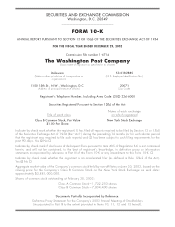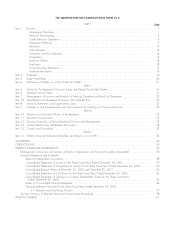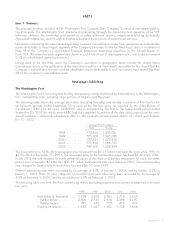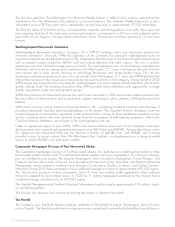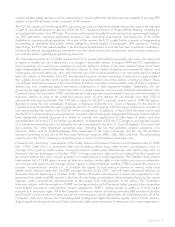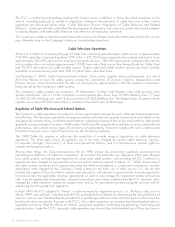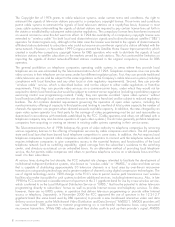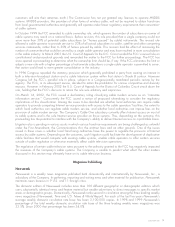Washington Post 2002 Annual Report Download - page 11
Download and view the complete annual report
Please find page 11 of the 2002 Washington Post annual report below. You can navigate through the pages in the report by either clicking on the pages listed below, or by using the keyword search tool below to find specific information within the annual report.customers will aim their antennas north.) The Commission has not yet granted any licenses to operate MVDDS
systems. MVDDS providers, like providers of other forms of wireless cable, will not be required to obtain franchises
from local governmental authorities and generally will operate under fewer regulatory requirements than convention-
al cable systems.
In October 1999 the FCC amended its cable ownership rule, which governs the number of subscribers an owner of
cable systems may reach on a national basis. Before revision, this rule provided that a single company could not
serve more than 30% of potential cable subscribers (or ‘‘homes passed’’ by cable) nationwide. The revised rule
allowed a cable operator to provide service to 30% of all actual subscribers to cable, satellite and other competing
services nationwide, rather than to 30% of homes passed by cable. This revision had the effect of increasing the
number of communities that could be served by a single cable operator and may have resulted in more consolidation
in the cable industry. In March 2001 the U.S. Court of Appeals for the D.C. Circuit voided the FCC’s revised rule on
constitutional and procedural grounds and remanded the matter to the FCC for further proceedings. The FCC has
since opened a proceeding to determine what the ownership limit should be, if any. If the FCC eliminates the limit or
adopts a new rule with a higher percentage of nationwide subscribers a single cable operator is permitted to serve,
that action could lead to even greater consolidation in the industry.
In 1996 Congress repealed the statutory provision which generally prohibited a party from owning an interest in
both a television broadcast station and a cable television system within that station’s Grade B contour. However
Congress left the FCC’s parallel rule in place, subject to a Congressionally mandated periodic review by the
agency. The FCC, in its subsequent review, decided to retain the prohibition for various competitive and diversity
reasons. However in February 2002 the U.S. Court of Appeals for the District of Columbia Circuit struck down the
rule, holding that the FCC’s decision to retain the rule was arbitrary and capricious.
On March 14, 2002, the FCC issued a declaratory ruling classifying cable modem service as an ‘‘interstate
information service.’’ Concurrently the FCC issued a notice of proposed rulemaking to consider the regulatory
implications of this classification. Among the issues to be decided are whether local authorities can require cable
operators to provide competing Internet service providers with access to the cable operators’ facilities, the extent to
which local authorities can regulate cable modem service, and whether local authorities can impose fees on the
provision of cable modem service. The Company’s Cable One subsidiary currently offers Internet access on most of
its cable systems and is the sole Internet service provider on those systems. Thus, depending on the outcome, this
proceeding has the potential to interfere with the Company’s ability to deliver Internet access on a profitable basis.
Litigation also is pending in various courts in which various franchise requirements are being challenged as unlawful
under the First Amendment, the Communications Act, the antitrust laws and on other grounds. One of the issues
raised in these cases is whether local franchising authorities have the power to regulate the provision of Internet
access by cable systems. Depending on the outcomes, such litigation could facilitate the development of duplicative
cable facilities that would compete with existing cable systems, enable cable operators to offer certain services
outside of cable regulation or otherwise materially affect cable television operations.
The regulation of certain cable television rates pursuant to the authority granted to the FCC has negatively impacted
the revenues of the Company’s cable systems. The Company is unable to predict what effect the other matters
discussed in this section may ultimately have on its cable television business.
Magazine Publishing
Newsweek
Newsweek is a weekly news magazine published both domestically and internationally by Newsweek, Inc., a
subsidiary of the Company. In gathering, reporting and writing news and other material for publication, Newsweek
maintains news bureaus in 9 U.S. and 11 foreign cities.
The domestic edition of Newsweek includes more than 100 different geographic or demographic editions which
carry substantially identical news and feature material but enable advertisers to direct messages to specific market
areas or demographic groups. Domestically, Newsweek ranks second in circulation among the three leading weekly
news magazines (Newsweek, Time and U.S. News & World Report). For each of the last five years Newsweek’s
average weekly domestic circulation rate base has been 3,100,000 copies. In 1998 and 1999 Newsweek’s
percentage of the total weekly domestic circulation rate base of the three leading weekly news magazines was
33.5%. Since 2000 that percentage has been 34.0%.
2002 FORM 10-K 9

